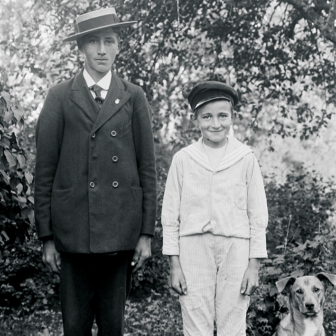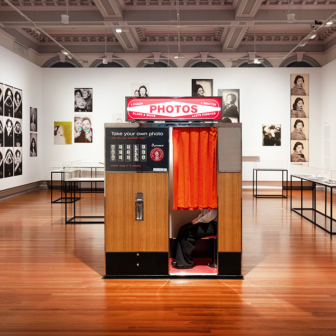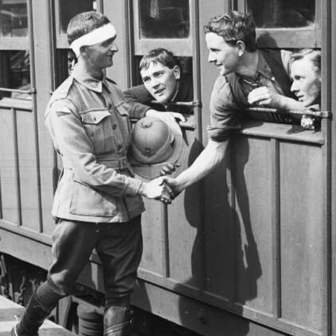Google Street View, by now a way of life, made its first appearance on our screens in 2007. In the company’s characteristically casual and upbeat account of those early days, things just sort of happened. “We packed several computers into the back of an SUV, stuck cameras, lasers and a GPS device on top, and drove around collecting our first imagery.” Those pictures of thoroughfares and laneways and suburban streets, captured in overlapping sequence by cameras stuck on cars, now account for nearly half the world. In more recent times they’ve been supplemented by increasing numbers of images from other sources: on- and off-street views contributed by members of the “street view community,” and images created through partnerships between Google and organisations both public and private, thereby allowing us to click on multiple views of the same street and in many instances to penetrate the street façade to see what lies behind.
This unimaginably large cache of images, each one morphing into its successor as we make our virtual way down the online street, forms a seemingly endless series of panoramas, allowing us to look up, look down, and swirl around places we have never been to, and may never see, other than on the screen. We can pause at any point, in effect creating a still photograph, ready-framed by the computer. (And if accessed via Google Earth, these views of the street can be toggled back and forth from 2-D to 3-D, a slightly unnerving experience.) We can embark on guided tours – of Angkor Wat, or Marseille by night – or we can just drift where the mood and the street take us, our perspective that of an SUV or a hatchback or perhaps a snowmobile or a launch. In many ways these self-guided walks, with no particular destination in mind, seem to echo what the great champion of urban studies, Jane Jacobs, saw as the essential quality of the ideal city – that there would always, just up ahead, be a corner, and around that corner would be a visual surprise. With Street View, there is always something new up ahead.
Many locations on Street View have now been photographed more than once. As of last April, we can “time travel,” comparing the differences between earlier and later views, spotting the obvious and the subtle changes that have occurred during this compressed aeon we all inhabit, this latterday common era that began in 2007. We could see the progress towards completion of the 2014 World Cup stadium in Brazil, suggested the Google Street View blog (and, as of this month, Google provides “360 degree street view access to all twelve stadiums”) or we can just as easily check on the rate of growth of that tree that the neighbours planted a few years ago, and try to predict how long it will before it is overshadowing our front garden. Or we can trace the differences between screenshots of the same location, differences that might be attributable to the weather or the season or the light, or to the presence or absence on the day when the photograph was taken of people and vehicles, or merely to the fact that, by the very nature of things, every view is new.
New, yet after a while, not so very surprising. Street View images, whether created in-house or outsourced, tend towards a very similar look. (This is not entirely by chance, given that “trusted photographers and trusted agencies are trained and certified by Google.”) The more corners you turn, the more the street in front begins to look like the one you’ve just left. Rather as one selfie, despite the infinite variety of human faces, can very quickly begin to look much like all the others – same expressions, same tilt of the head – so these streets can begin to blend into one another, making it difficult to retain any memory of their distinctiveness. The parallels between the rises of the Street View and the selfie don’t end there. Together they embody much of our confused thinking about the opposing impulses towards privacy and display.
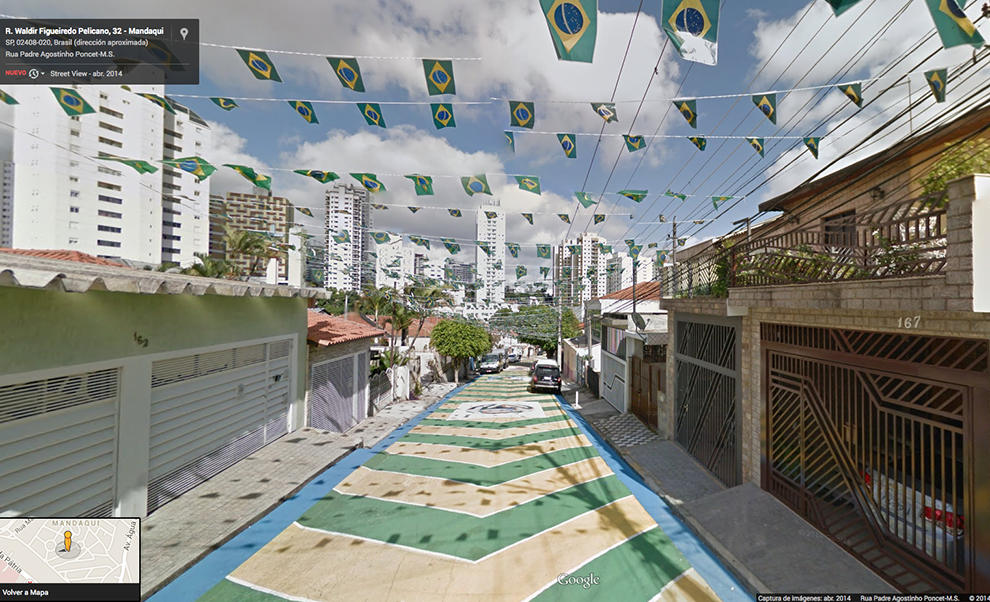
Something new up ahead: Google Street View at the World Cup.
In the selfie, it is all about the face. Its owner is recognisable, even if the face is a deliberately silly one, while the background setting is mostly blurry or non-specific. It’s exactly the opposite with Street View – the background is sharp, sharp enough to assume the foreground, but any people who happen to have been caught in the shot are simply there as extras, placed like the little figures in architectural models, dropped in to suggest an approximation of scale. And thanks to technology deployed by Google since 2008, the faces of anyone likely to be identifiable have been rendered as essentially featureless. “If one of our images contains an identifiable face (for example that of a passer-by on the sidewalk),” runs an undertaking from Google, “our technology will automatically blur it out.” And if the technology slips up, there is a mechanism by which the identifiable individual can apply to be made faceless. You can, in effect, opt for an unselfie.
A long session spent scrolling through images on Street View is like watching one of those real-life documentaries, the ones in which every so often a face, usually of someone in the background who is visible only for a moment, has been blanked out. The difference is that on Street View the blanked-out faces are the norm rather than the exception. Street View, in fact, is all about anonymity. Even the images are created anonymously, the cameras sitting alone on the vehicle roof taking pictures automatically at preordained intervals.
What does it mean to photograph a street? Can a street be a street in the full sense of the term if the people have had their faces blotted out? For contemporary practitioners and aficionados of the genre known as “street photography,” the answer would almost certainly be no. “Street photography” means something a long way from the kind of images that appear on Street View. To begin with, the street is the least of it. The “street” bit has instead become code for something else, for a way of capturing the human face as it appears in a (usually) unguarded moment, for the determination of the photographer to catch that moment when private expression and mood interact with the camera to produce an arresting image.
A street photographer needs to be ever alert for that moment, and for that he or she must travel fast and travel light, and be ready to shoot regardless of location. The Wikipedia entry for street photography puts it baldly. Street photography, we are told, “does not necessitate the presence of a street.” It might once have done, but street photography has moved on from its origins in depicting the urban landscape, with or without human figures, to become a way of photographing people wherever they might be, on or off the avenue.
Meanwhile, the street, no longer an essential component of the photographic genre named after it, has sought refuge elsewhere, under the umbrella of what is more often called urban (or urban landscape) photography. Here, the focus returns to the built environment, an environment in which people are present, if at all, as extras rather than leading players. The urban photographer also seeks to capture mood and expression, but in this case it is the mood and expression of the city and its streets, rather than of individual inhabitants.
The distinction between street and urban photography is also a distinction between different kinds of photographers. Street photographers often have, and just as often cultivate, something of a frontline image, presenting themselves as confident and fearless, prepared to enter dangerous places and potentially volatile situations on our behalf in order to send back images to those of us who spend rather a lot of time inside. Websites dedicated to street photography will typically provide advice on how the would-be practitioner should approach people who might potentially be subjects, emphasising the importance of behaving in a self-assured, professional manner and not as a diffident bumbler, weighed down by too much equipment.
The alternative, to photograph the city and its actual, non-metaphorical streets while steering clear of anyone who might prove difficult and who might object to your intrusiveness – to be, in other words, an urban photographer – is by implication seen as a lesser calling. After all, photographing a street without people in it, or without people as the intended subject, is something that a car, with a camera on the roof and its shutter set to automatic, can easily do.
But urban photography can be risky too, particularly if you change the point of view from ground level to somewhere much higher. Which might explain why there are so many aerial shots around nowadays. Not only does the aerial shot provide a perspective that is not part of normal everyday experience for most people, thereby leading us to look anew, but also recent iterations of aerial photography will often emphasise the daring and the danger involved in capturing these images from above.
The photographer George Steinmetz, for instance, a contributor to National Geographic, takes pictures from a motorised paraglider. The first time he went up he was nervous. “It was really quite petrifying. And I thought, wait a minute, I’m up here, I’m really determined to get this picture, so I better take the fucking picture! If you’re going to die, at least get the picture first. Don’t die for nothing.” A picture, in other words, is worth dying for, which is certainly setting the paraglider very high.
Steinmetz’s aerial shot of the remains of Leptis Magna, the largest Roman city in Libya, clearly delineates the layout of the streets below and provides a perspective that could never be captured by a camera on the ground. Added to that, and in the back of our minds, is the knowledge that the image was taken, not by a satellite or aircraft-borne device set to auto, but by a man hanging in the air in a flimsy machine, above a land in the midst of post-revolutionary turmoil.
Yet the fact is that we can also zero in on Leptis Magna via Google Earth, where we will be presented with both satellite images and links to other photographs taken at ground level, and thus with the opportunity to create our own composite view of Leptis Magna. For the moment the satellite images cannot quite match the quality and resolution of one taken by a professional photographer from a paraglider, but one day soon they will, and then an awareness of how the images were created – by a satellite or by a man in a paraglider – will become an even more important element in the overall impact of the individual, photographic image.
But then it has probably always been the case that the story around the photograph is an essential component of the story that we make from the photograph. “A photo becomes fictional on the basis of the text beside it, or the photos that precede it or follow it,” says the novelist and photographer Teju Cole, discussing his photographic novel on life in Lagos, Every Day Is for the Thief. Context is everything. The photographs taken in the early 1850s by one of the first and the greatest of urban photographers, Charles Marville, recently on exhibition at the Metropolitan Museum of Art in New York, derive much of their continuing impact from our knowledge that their subject, the streets of pre-Haussmann Paris, were soon to be swept away and their inhabitants unceremoniously forced out.
The images created in the 1940s by a much less well-known photographer of the urban landscape, Fredrik Bruno, show, in quietly contemplative and bleached-out colour compositions, the streets of various Swedish towns and cities, some with people and some without, as they appeared during the years of the second world war and immediately afterwards. The serenity of these streets takes on a more complex cast because we know that, in neutral Sweden, they were an exception among the devastation that was taking place across the rest of Europe. In both cases, our knowledge of context helps us to animate the still image, and to imagine the lives of the people whose streets they were.
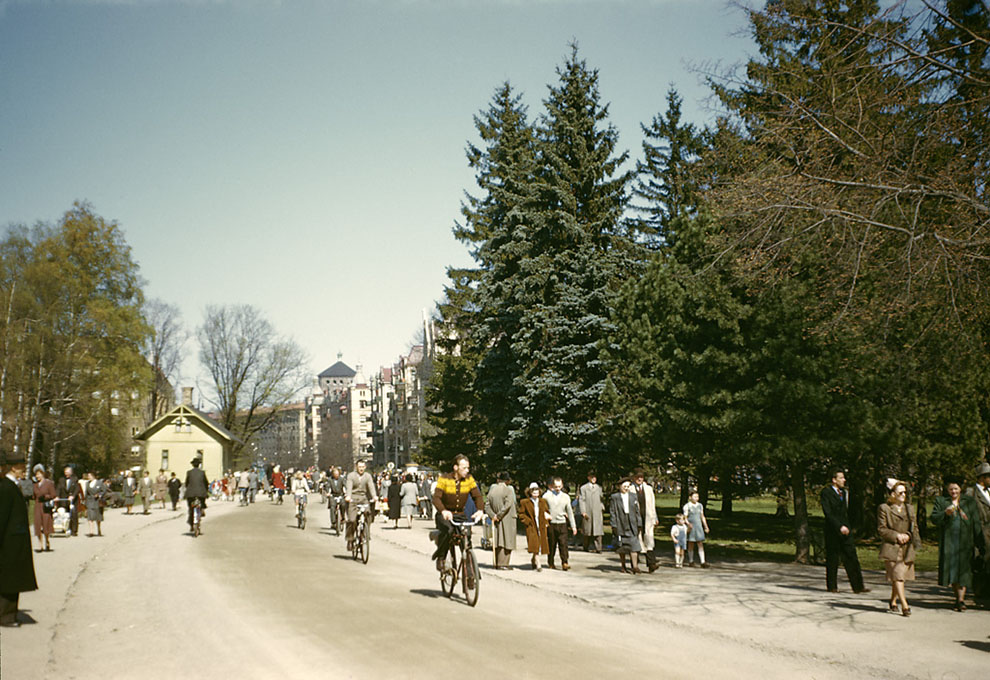
Amid the devastation: Fredrik Bruno’s “Vasagatan street towards Tegelbacken in Stockholm city” (c. 1943). Swedish National Heritage Board
For aspiring urban or street photographers today, a large part of the context for their work is the ever-growing presence of Street View, Google Earth and Apple Maps, and other applications that depend for their raw material on huge numbers of automatically generated images, taken from satellite or aeroplane, car or Google Trekker, and how this multiplying mass of images makes it ever harder to claim attention for an artisanal, distinctive and distinguishing view of the urban landscape, or indeed of any landscape.
For increasing numbers of photographic artists, the answer is to mine these seams of images, selecting carefully from the vast array and putting their stamp on a chosen few. Benjamin Grant produces Daily Overview, where he posts enhanced aerial images derived from Apple Maps that chime with ideas or themes that he wants to explore, concentrating, as he explains in an interview, “only on the areas where humans – for better or worse – have impacted the landscape.” Grant likens himself to an explorer, searching Apple Maps for just the right images, which he then manipulates, changing the angle of perception and enhancing the depth of colour and, it could be argued (though he does not), making them his own.
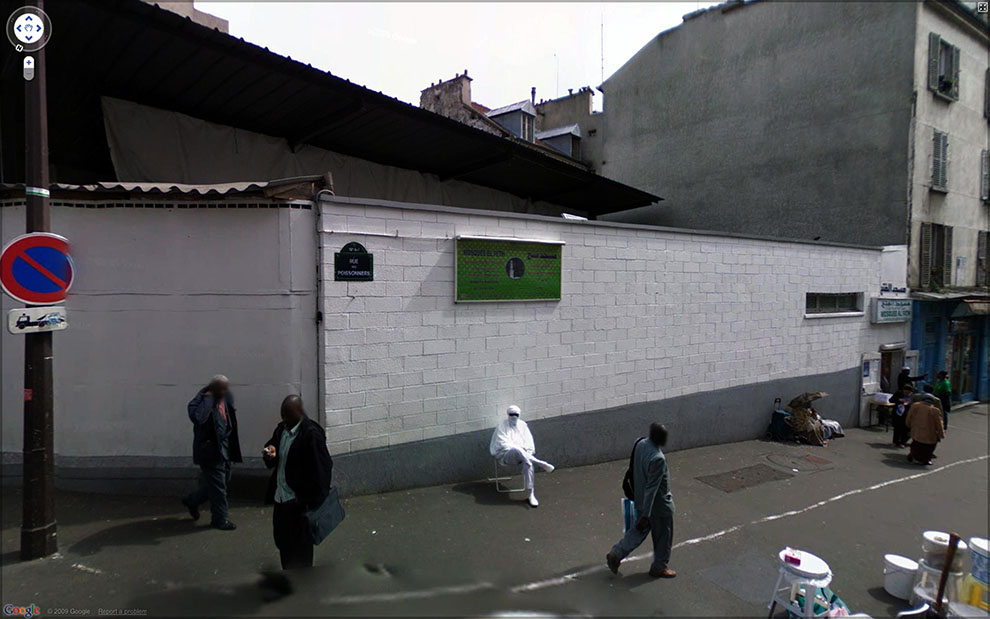
Something more: From Jon Rafman’s series, Nine Eyes of Google Street View. Ars Electronica/ Flickr
It’s the same on the ground. “Who’d have thought,” asks the novelist and photography writer Geoff Dyer, “that you could be a stay-at-home street photographer?” But as he points out, you could and you can, by searching Street View for just the right image to appropriate, re-format and even to rephotograph. Practitioners of this sub-branch of the photographic arts, like Jon Rafman or Michael Wolf, will look to draw something more from the house style of Street View, with its mechanical recording of architecture and topography, than it initially seems to offer. Sometimes what they are looking for is the Street View image that suggests a theme, such as urban decay, but more often it is the occasional shot that, despite the blanked out faces, still manages to bring to the foreground the human element that underpins the character of any street.
These occasional images might be of a couple embracing, or having an argument; they might be of an individual collapsed in the gutter, or a prankster who has spotted the approaching car and is acting up for the camera. What is required of the rephotographer is not so much a spirit of derring-do as the capacity to spend the long hours required to sift the archive, always with a highly developed curatorial eye open for those images that, with a bit of help, will stand out from the crowd. •


